Author: Himanshu Patni
07 November 2023
Introduction
Wearable devices, encompassing smartwatches, fitness trackers, and other portable gadgets, have gained popularity in recent years. Their ability to collect and analyze data about our bodies has become a game-changer. From heart rate monitoring to sleep tracking and even stress management, these devices provide valuable insights into our overall health and promote proactive health management. One of the primary advantages of wearable devices is their ability to effortlessly integrate into our daily lives. These devices can keep track of our physical activities, encouraging a more active lifestyle. By monitoring our steps, distance covered, and calories burned, they offer real-time feedback, motivating us to achieve our fitness goals. In turn, this helps reduce the risk of chronic diseases such as obesity, diabetes, and cardiovascular disorders.
Unlock Insights: Receive a Sample Research Report on the wearable healthcare devices market:https://univdatos.com/get-a-free-sample-form-php/?product_id=19573
Moreover, wearables have also revolutionized the field of preventative healthcare. They can detect and monitor various health indicators such as blood pressure, heart rate variability, and even oxygen saturation levels. This wealth of information is invaluable in identifying potential health concerns at an early stage, allowing for timely prevention or intervention. Ultimately, wearables promote a proactive approach to health, shifting the focus from treating illnesses to preventing them. Furthermore, wearable devices can also provide comprehensive analysis of our sleeping patterns. By monitoring our sleep duration, quality, and stages, these devices empower us to make informed decisions regarding our sleep hygiene. Sleep is a vital component of good health, and understanding our sleep patterns can help us adopt healthier habits, improving overall well-being and boosting productivity.
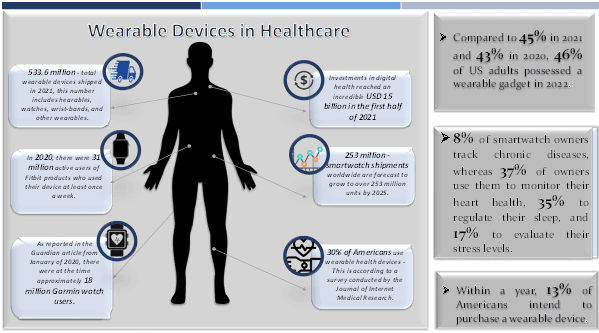
The ability of wearables to track stress levels is another remarkable feature. In today’s fast-paced world, stress has become an almost constant companion. These devices monitor heart rate variability, a useful indicator of stress levels, and provide personalized stress management techniques. By offering relaxation exercises, guided breathing, and mindfulness practices, wearables contribute to reducing stress, enhancing mental health, and promoting overall wellness.
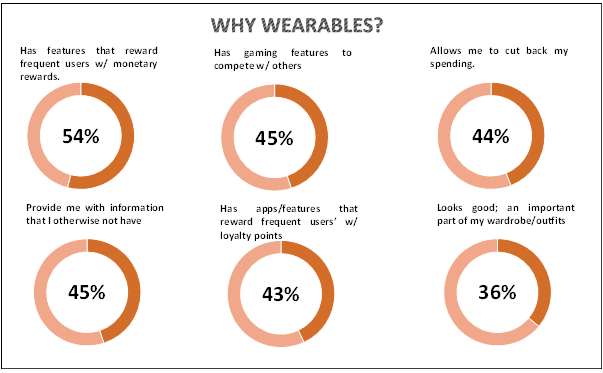
According to the leading consulting firm, adults with at least one child in their household have a significantly higher likelihood (49%) of owning multiple wearable devices compared to non-parents (24%). Similar to all consumers, parents primarily bought these devices for health reasons (20%). Conversely, a majority of non-parents received their first wearable device as a gift (18%). Parents also exhibit a more positive perception of wearable technology compared to both non-parents and the general consumer population. Additionally, parents are less inclined to believe that wearable technology will negatively impact their ability to connect with others, infringe upon their privacy, or make them susceptible to security breaches.
Parents believe an increase in wearable technology can improve their:
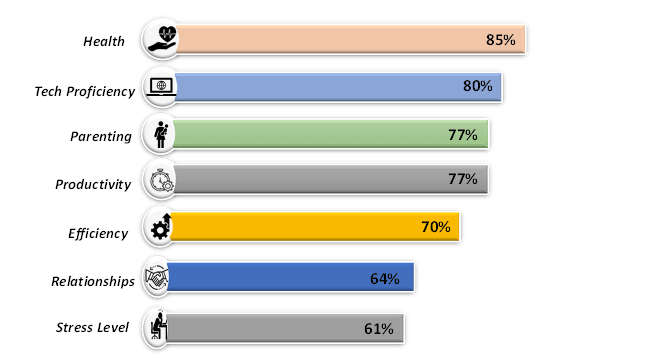
Parents are Early Adopters
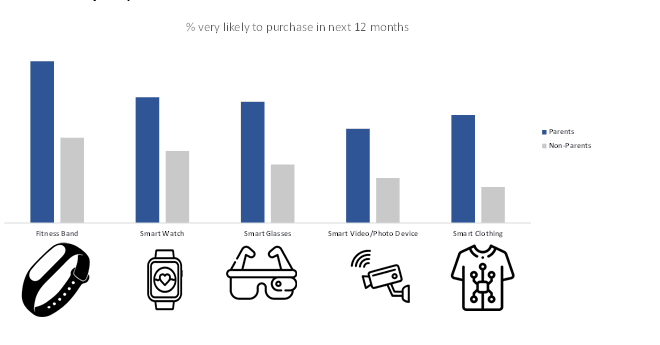
Smartwatches – Unleashing the Health Potential
In recent years, there has been an exponential rise in the adoption of smartwatches within the healthcare industry. These wearable devices, equipped with advanced sensors and intelligent features, offer a myriad of benefits for both patients and healthcare professionals. In this blog, we will explore the fascinating statistics behind the rising adoption of smartwatches in healthcare, highlighting how these devices are transforming the way healthcare is delivered and managed. A study published in the Journal of Medical Internet Research (JMIR) found that 91% of participants who were using a smartwatch reported experiencing positive health behavior changes. The study included 2,763 participants who used various smartwatches to monitor their health-related activities.
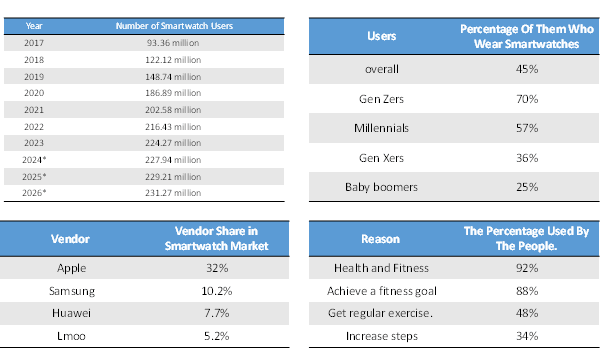
Analysis for Usage of Smartwatches among US population
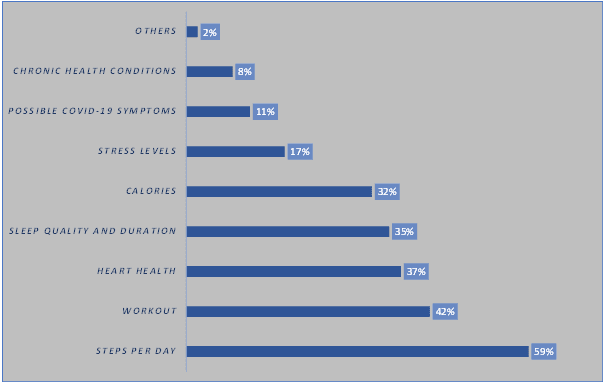
Market Analysis
According to Univdatos Market Insight, the market for wearable healthcare devices has been experiencing significant growth in recent years and is expected to continue to expand at a rapid rate. This can be attributed to several factors such as increasing healthcare awareness, growing prevalence of chronic diseases, and advancements in technology. One of the key drivers of this market is the rising adoption of wearable devices among consumers. These devices, which include smartwatches, fitness trackers, and health monitors, allow individuals to track their health parameters such as heart rate, blood pressure, and sleep patterns. This has led to an increasing demand for wearable healthcare devices as they provide real-time health monitoring, enabling individuals to take proactive steps towards improving their health. Another factor contributing to the growth of this market is the increasing focus on preventive healthcare. Governments and healthcare organizations across the globe are emphasizing the importance of early detection and prevention of diseases. Wearable healthcare devices play a crucial role in this aspect by enabling individuals to monitor their health on a regular basis, identify potential health risks, and take preventive measures.
Regional Analysis
As per UnivDatos Market Insight analysis, North America has been dominating the wearable healthcare devices market, accounting for the largest share in terms of revenue in 2022. This can be attributed to the presence of key market players, high healthcare expenditure, and a technologically advanced healthcare infrastructure. Moreover, the region has a large population of tech-savvy individuals who are more likely to adopt wearable healthcare devices.
Europe is also a significant market for wearable healthcare devices, owing to the increasing awareness about personal health among the population. The region has a well-established healthcare system and a high prevalence of chronic diseases, which are driving the demand for wearable devices. Additionally, the aging population in Europe is fueling the growth of this market as older adults are more likely to require continuous health monitoring. Moreover, the report also suggests that Asia Pacific is expected to witness substantial growth in the wearable healthcare devices market in the coming years. The region has a large population and a rising middle class with increasing disposable income. Moreover, the governments in countries like China and India are focusing on improving healthcare infrastructure and access to healthcare, which is expected to drive the adoption of wearable healthcare devices.
Conclusion
The wearable device market in healthcare has experienced rapid growth and technological advancements in recent years. These wearable devices, also known as wearables, are electronic devices worn on the body that can track, collect, and analyze a person’s health and fitness data. These devices have the potential to revolutionize the way healthcare is delivered by allowing individuals to monitor their health in real-time and providing valuable insights to both patients and healthcare providers. However, challenges such as data accuracy and privacy must be addressed to fully harness the potential of wearables in the healthcare market. With continued advancements and regulatory measures, wearables are poised to revolutionize the way healthcare is delivered, empowering individuals to take control of their health and well-being. Based on our study, we strongly believe that the market is projected to experience significant investments in the coming years, driven by several factors. Moreover, the increasing focus on preventive healthcare and wellness among individuals is fueling the demand for wearable healthcare devices. Users are becoming more conscious of their lifestyle choices and are actively seeking ways to monitor and improve their health. This trend presents a significant opportunity for market expansion, as wearable devices cater to the need for personalized and proactive healthcare solutions. Lastly, the market is witnessing a surge in investments and collaborations among major players to innovate and develop technologically advanced wearables. This trend indicates the confidence of industry leaders in the future potential of this market and underscores the promising opportunities for investors.
Get a call back